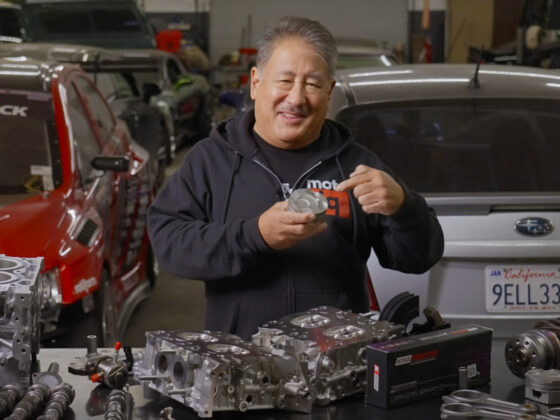
The Figs rotors use these captive nuts to ease assembly and disassembly. The friction rings are back-mounted on the hats for better air circulation. Alloy hats save 4 lbs per rotor over the one-piece TRD rotors despite being bigger!

You can see the slots allowing for thermal radial growth here under the bolts. On the one-piece rotor, this growth would be constrained by the cast-in hat and would cause uneven growth between the inner and outer face of the rotor causing it to distort like a cone. That is not going to happen here. The Figs rotor is slotted with oval vents inside the slot. During hard braking, the slots sweep the hot zone of vaporized pad material improving pad bite. The vents give the hot gas somewhere to go. The slots and vents also help the pads bite better under wet conditions.

For the rear, we used EBC OEM replacement rotors. The EBC rotors are a high-quality sports upgrade rotor that is a direct replacement for the stock part. EBC rotors are made of a high-carbon iron alloy that is compatible with the friction material of EBC brake pads. We got our EBC parts for the rear of our truck from SQHD in Arizona, the off road performance shop where we have gotten many of the parts for our Project Tundra.

The EBC rotors retain the OEM integral parking brake drum. The rotors are zinc-plated then have a layer of Thermic black coating on top of that for additional corrosion resistance.




15 comments
I’m lost on why a radial mounted caliper is better when it has an adapter that bolts in the same as the TRD?
Yeah, technically the mount shouldn’t be much stiffer, but the caliper itself will flex less. Be interesting to see in FEA. To do it right you need a new hub. I always thought the radial design was too make it easier to install bigger discs on motorcycles. You can just shim it instead of needing new calipers.
The adaptor is bridged and many times stiffer than the OEM ears.
Very nice brakes. Really like the front rotor design. Does the master cylinder flex the firewall? There can be huge improvement in brake feel with a master cylinder brace, at least on compact cars.
Nice looking kit. How do you like the yellow stuff pads? I’m going to throw the blue stuff on my lx470 soon. I like their compounds and the fact that their pads don’t delaminate like other brands.
I haven’t run their stuff in a long time, they used to work well but wore fast and were dusty, these seem not to dust so far.
Hi Mike,
Two quick questions.
Do the Fig’s front pads have a similar coefficient of friction characteristics to the EBC’s?
If running a front brake upgrade such as this, with stock rear calipers, pads, and rotors, is it better from a brake bias standpoint to run pads with a higher coefficient of friction in the rear, if you find that the front end now tends to dive, with increased ABS activity under braking? Assuming that you do not want to add a proportioning valve to the system, and you have factory ABS and traction control present.
I don’t know the mu for the figs pads but the EBC is 0.42. The Figs pads don’t have tons of initial bite which is ok because the brakes have a lot of torque and I got the less aggressive of the two pads offered. The system feels like the pistons are slightly smaller than the TRD calipers. I would like to increase the rear pad volume for longer service life to match the fronts.
Not to be pedantic, but I think the yellows are advertised .48 while the blues are . 52. If you can get orangestuffs their mu is around .6
The Current EBC website doesnt list a Mu for the yellow which were recently reformulated. I found some old information that said .42.
How can I get these products 2017 Tundra
I mean we have links to Figs engineering in the story.
Hi Mike,
Can you tell me what you did with the dust plate on the front brakes? I’m installing but finding a 1mm gap from the spindle housing and the wheel hub. Worried about dust/debris. What did you guys do with that dust plate to make room for the large rotors? I wanted to just discard but thinking I may need so just cut them way back. Any help please?
Mike
Remove it
Thanks Mike. What about the 1mm gap that remains. No concerns with that small gap that was usually taken up by the dust shield?